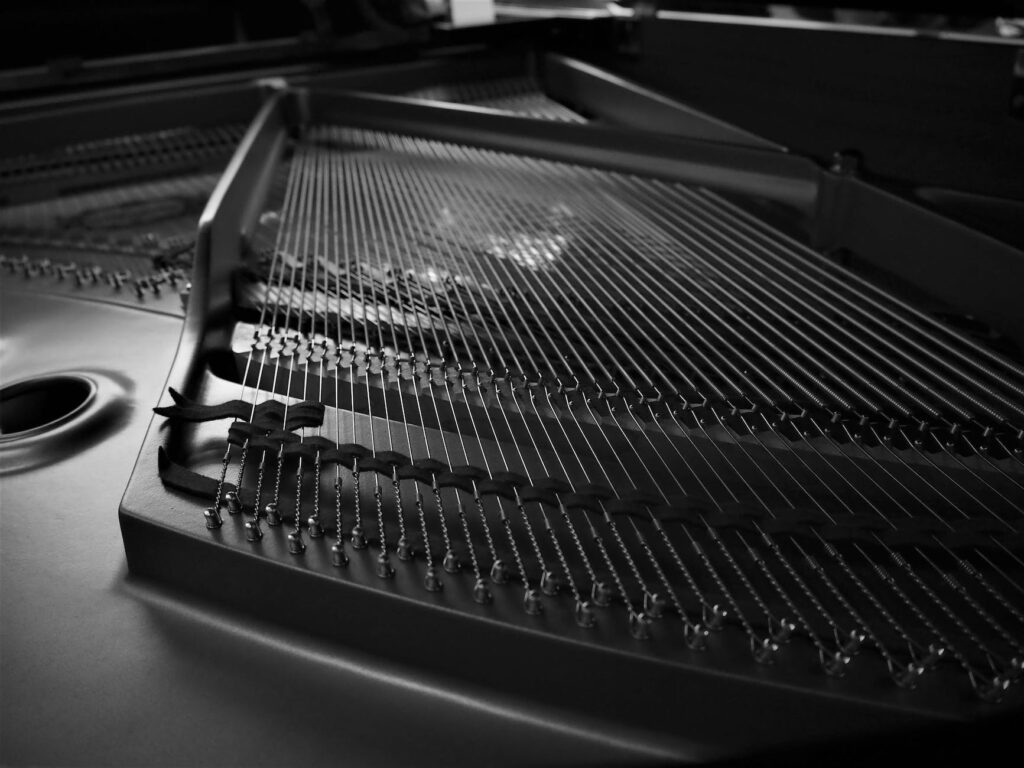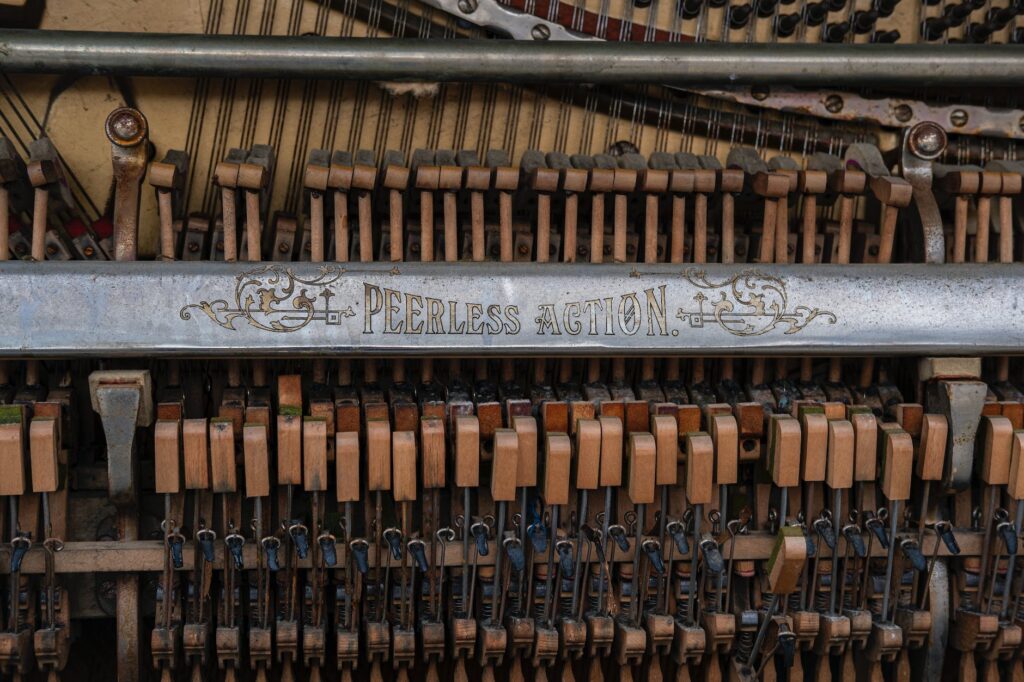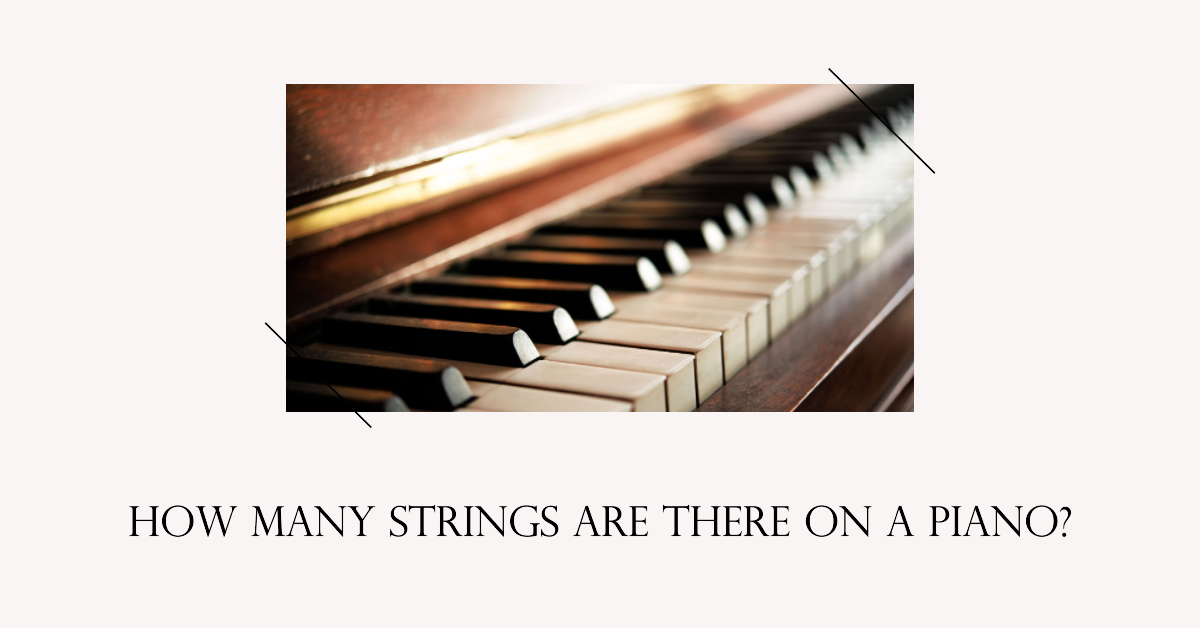Overview
The strings in a piano are responsible for producing sound. When a key is pressed, it activates a hammer that strikes one or more strings, causing them to vibrate and produce sound. The strings are held under high tension, and their varying lengths, thicknesses, and materials contribute to the piano’s wide range of pitches and tones.
How piano strings produce sound
The sound produced by piano strings is a result of their vibration. When a hammer strikes a string, it causes the string to vibrate at a specific frequency, which produces a corresponding pitch. The soundboard, a large wooden panel within the piano, amplifies these vibrations, resulting in the rich and resonant sound we associate with the instrument.
The number of strings in a piano varies depending on the type and model, but most have between 200 and 230 strings.
Whether you’re looking for a small piano, a digital piano, or searching for the best MIDI keyboard, the number of strings in an acoustic piano is an essential factor to consider. As we explore in the upcoming sections, the specific number of strings in a piano can impact its sound quality, playability, and maintenance requirements.
| Key Takeaways |
|---|
| 1. The number of strings in a piano varies depending on the type and model. |
| 2. Most acoustic pianos have between 200 and 230 strings. |
| 3. String count is influenced by factors such as piano size, manufacturer’s design choices, and custom or experimental designs. |
| 4. String count impacts the sound quality, tuning stability, and maintenance requirements. |
| 5. When choosing a piano, consider not only the string count but also size, manufacturer, and personal preferences. |
| 6. The piano is a beautiful and complex instrument, with string count playing a crucial role in defining its unique sound and character. |
| 7. Innovations in piano design, including string count, will continue to shape the future of piano music. |
Analysis of a piano

Components of a piano
a. Frame
The frame is the structural foundation of a piano, supporting the soundboard, strings, and action mechanism. In acoustic pianos, the frame is typically made of cast iron, providing the necessary strength to withstand the high tension of the strings.
b. Soundboard
The soundboard is a large wooden panel, usually made of spruce, that amplifies the vibrations of the strings. The soundboard’s shape and quality significantly impact the piano’s tonal characteristics.
c. Strings
Piano strings are made of steel wire, with the lower-pitched bass strings wrapped in copper to increase their mass. The strings are arranged in groups, with each group corresponding to a specific key on the keyboard.
d. Hammers and action mechanism
The action mechanism is the system of levers, springs, and dampers that translates the motion of the keys into the movement of the hammers. When a key is pressed, the action mechanism causes a felt-covered hammer to strike the corresponding string(s), producing sound.
How the components work together to produce sound
When a key is pressed, the action mechanism triggers the corresponding hammer to strike the string(s). The vibrating string causes the soundboard to resonate, amplifying the sound and producing the rich, full-tone characteristic of pianos.
Types of pianos and their string counts

Grand pianos
a. Explanation of the grand piano structure
Grand pianos are large, horizontal pianos with strings and action mechanisms laid out parallel to the floor. They are known for their superior sound quality and responsiveness, thanks to their larger soundboards and more efficient action mechanisms.
b. Range of string counts in grand pianos (e.g., 220 to 230 strings)
Most grand pianos have between 220 and 230 strings, depending on their size and manufacturer’s design choices. The larger soundboard and longer strings of grand pianos contribute to their rich, resonant sound.
c. Examples of different grand piano models and their string counts
Examples of grand piano models with varying string counts include the Steinway Model D (243 strings), the Bösendorfer Imperial (266 strings), and the Yamaha CFX (234 strings). Each model has its unique characteristics and tonal qualities.
Upright pianos
a. Explanation of the upright piano structure
Upright pianos are vertical pianos with strings and action mechanisms arranged vertically, saving space and making them suitable for home use. While their sound quality and responsiveness may not be on par with grand pianos, many modern upright pianos offer impressive performance at a more affordable price. Learn more about upright piano structures in this Yamaha YDP-145 and YDP-S35 review.
b. Range of string counts in upright pianos (e.g., 200 to 220 strings)
Upright pianos typically have between 200 and 220 strings, with the exact number depending on factors such as size and manufacturer’s design choices. While upright pianos generally have fewer strings than grand pianos, they still offer a wide range of tonal possibilities.
c. Examples of different upright piano models and their string counts
Examples of upright piano models with different string counts include the Steinway Model 1098 (202 strings), the Yamaha U1 (214 strings), and the Kawai K-300 (218 strings). Each of these models provides a unique playing experience and sound quality.
Digital pianos and keyboards
a. Explanation of digital piano technology
Digital pianos and keyboards are electronic instruments that use digital technology to replicate the sound of an acoustic piano. They don’t have physical strings but instead, use digital samples or sound synthesis to create piano-like tones. You can find more information about digital piano technology in this digital piano vs. MIDI keyboard comparison.
b. Lack of physical strings in digital pianos
As mentioned earlier, digital pianos don’t have physical strings. Instead, they rely on digital samples or sound synthesis to produce piano-like tones. This means that the concept of string count does not apply to digital pianos.
c. Comparison of sound quality between digital pianos and acoustic pianos
While digital pianos have made significant advancements in recent years, many musicians still prefer the sound of an acoustic piano. Acoustic pianos offer a more authentic playing experience, with nuances in tone and responsiveness that are challenging to replicate digitally. However, digital pianos can still be an excellent choice for beginners or those with space and budget constraints. For more information on the sound quality of digital pianos, check out this list of the best beginner keyboards under $300.
Factors that influence the number of strings in a piano

Piano size
a. How the size of a piano impacts its string count
The size of a piano has a direct impact on its string count. Larger pianos have more room for longer strings, which results in a wider tonal range and more strings overall. Conversely, smaller pianos have less space for strings and may have a reduced string count and tonal range.
b. Relationship between piano size and tonal range
As the size of a piano increases, so does its tonal range. Longer strings in larger pianos can produce deeper bass notes and more resonant treble notes, resulting in a broader tonal palette. Smaller pianos, with their shorter strings and smaller soundboards, may have a more limited tonal range in comparison.
Manufacturer’s design choices
a. How piano manufacturers decide on the number of strings in their models
Piano manufacturers often make design choices based on factors such as cost, market demand, and their unique design philosophies. These decisions can affect the number of strings in a piano, as well as other aspects of the instrument’s performance and appearance.
b. Examples of manufacturers with unique string counts
Some manufacturers, such as Bösendorfer and Fazioli, are known for their unique string counts and innovative designs. Bösendorfer’s Imperial model, for example, features 266 strings and an extended range, while Fazioli’s F308 model has 232 strings and a fourth pedal for additional tonal control. These unique string counts are a result of the manufacturer’s design choices and commitment to delivering a distinct playing experience.
Custom pianos and experimental designs
a. Overview of custom-built pianos
Custom-built pianos are designed and constructed according to the specific requirements of an individual or organization. These pianos can feature unique string counts, sizes, or other features tailored to the customer’s preferences.
b. Examples of pianos with unusual string counts or configurations
Some custom and experimental piano designs have incorporated unusual string counts or configurations. For example, the Stuart & Sons piano has 108 keys (instead of the standard 88), resulting in a higher string count and an extended tonal range. Similarly, the Una Corda piano, designed by David Klavins, features a unique single-string-per-note configuration, which gives it a distinct sound and character.
c. Discussion of the impact of these designs on sound quality and playability
Custom pianos with unique string counts or configurations can offer a different playing experience and sound quality compared to traditional piano models. While some musicians may appreciate the expanded tonal range or unique tonal characteristics of these instruments, others may prefer the familiarity and consistency of standard piano designs.
Importance of string count in pianos

Relationship between string count and sound quality
a. How string count affects a piano’s tonal range, volume, and resonance
The string count in a piano can have a significant impact on its sound quality. Pianos with a higher string count typically have a wider tonal range, allowing for more expressive playing and a greater variety of musical possibilities. Additionally, a higher string count can contribute to increased volume and resonance, resulting in a richer and more powerful sound.
b. Examples of pianos with high and low string counts and their respective sound qualities
Pianos with high string counts, such as the Bösendorfer Imperial or the Fazioli F308, are known for their exceptional sound quality and expanded tonal range. In contrast, smaller pianos with fewer strings, like some entry-level upright models, may have a more limited tonal range and lower volume.
String count and tuning stability
a. Explanation of how string count impacts tuning stability
The string count in a piano can influence its tuning stability. Pianos with a higher string count have more strings under tension, which can make them more susceptible to changes in temperature and humidity. As a result, these pianos may require more frequent tuning and maintenance to maintain their optimal performance.
b. Comparison of tuning stability in pianos with different string counts
Pianos with fewer strings, such as some upright models, may have better tuning stability due to their lower overall string tension. However, this advantage may be offset by their more limited tonal range and lower sound quality compared to pianos with a higher string count.
String count and maintenance
a. Challenges of maintaining a piano with a higher string count
Maintaining a piano with a high string count can be more challenging than one with fewer strings. Pianos with more strings require more frequent tuning and may be more sensitive to changes in their environment, such as temperature and humidity fluctuations. Additionally, replacing broken strings or repairing other issues related to the higher string count can be more time-consuming and costly.
b. Comparison of maintenance requirements for pianos with varying string counts
While pianos with a higher string count may offer superior sound quality and tonal range, they also tend to have higher maintenance requirements compared to those with fewer strings. Pianos with a lower string count generally require less frequent tuning and may be less susceptible to environmental factors. However, it is important to consider the trade-offs between sound quality, tonal range, and maintenance requirements when choosing a piano.
Conclusion
Recap of main points
1. The number of strings in a piano varies depending on the type and model
As discussed in this blog, the number of strings in a piano can vary widely depending on the type of piano (e.g., grand, upright, or digital) and the specific model. Generally, grand pianos have more strings than upright pianos, while digital pianos don’t have physical strings at all.
2. Most pianos have between 200 and 230 strings
While the exact number of strings can differ between pianos, most acoustic pianos have between 200 and 230 strings. This range is influenced by factors such as piano size, manufacturer’s design choices, and custom or experimental designs.
3. Factors that influence string count include piano size, manufacturer’s design choices, and custom or experimental designs
The string count in a piano can be affected by the size of the instrument, with larger pianos typically having more strings and a broader tonal range. Manufacturer’s design choices also play a role in determining string count, as do custom or experimental piano designs that push the boundaries of traditional piano construction.
Importance of understanding string count in pianos
1. Impact of string count on sound quality, tuning stability, and maintenance
String count can have a significant impact on a piano’s sound quality, tuning stability, and maintenance requirements. Understanding these factors can help musicians and piano enthusiasts make more informed decisions when selecting an instrument that meets their needs and preferences.
2. Considerations for choosing a piano based on string count and personal preferences
When choosing a piano, it’s essential to consider not only the instrument’s string count but also factors such as size, manufacturer, and individual playing preferences. Balancing these considerations can help ensure that the chosen piano provides a satisfying and rewarding playing experience.
Final thoughts
1. The beauty and complexity of the piano as an instrument
The piano is a beautiful and complex instrument, with its rich history and intricate design contributing to its enduring appeal. The number of strings in a piano is just one aspect of its construction, but it plays a crucial role in defining the instrument’s unique sound and character.
2. The ongoing evolution of piano design and the role of string count in shaping the future of piano music
As piano design continues to evolve, innovations in string count and other aspects of piano construction will undoubtedly shape the future of piano music. By understanding the role of string count in pianos, musicians and enthusiasts can better appreciate the intricacies of this beloved instrument and the boundless possibilities it offers for musical expression. For more information on the differences between digital pianos and acoustic pianos, visit this comparison guide.





